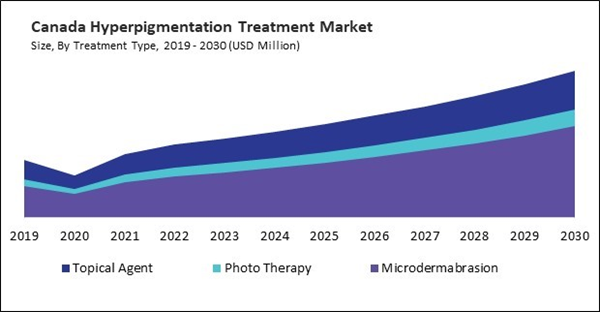The US market dominated the North America Hyperpigmentation Treatment Market by Country in 2022, and would continue to be a dominant market till 2030; thereby, achieving a market value of $2,287.3 million by 2030. The Canada market is experiencing a CAGR of 9.8% during (2023 - 2030). Additionally, The Mexico market would experience a CAGR of 8.9% during (2023 - 2030).
The trend toward personalized skincare regimens has permeated the hyperpigmentation treatment market. Consumers increasingly seek treatments tailored to their skin types, concerns, and lifestyles. The availability of personalized treatment plans, incorporating a mix of topical formulations, laser therapies, and other interventions, enhances the overall efficacy of hyperpigmentation treatments and fosters a sense of individualized care. The psychological and aesthetic impact of hyperpigmentation on an individual’s confidence and self-esteem is a significant driver for adoption. As societal attitudes shift towards recognizing the importance of mental well-being and self-confidence, more people are actively seeking solutions to address pigmentation concerns, viewing these treatments as improving their skin’s appearance and overall quality of life.
It is associated with hormonal fluctuations, pregnancy, and the sun exposure, melasma is a prevalent skin condition characterized by dark patches, which frequently appear on the face. Hyperpigmentation treatments are frequently employed to lighten these dark patches and improve overall skin tone. PIH occurs because of skin inflammation, such as acne or other injuries. Hyperpigmentation treatments help reduce the discoloration left behind after the inflammatory process, promoting a more even skin tone. Sunspots, age spots, or hyperpigmentation areas can form due to prolonged sun exposure.
According to the Canadian Institute for Health Information, Canada’s senior population of those 65 and older will expand by 68% over the next 20 years. It has more than tripled in size in the last 40 years. In 2017, it was around 6.2 million. It is anticipated to reach 10.4 million in 2037. This population in Canada is projected to increase by 2.1 times by 2037 from its size in 2017. Hence, the factors mentioned above will drive the regional market growth.
Based on Treatment Type, the market is segmented into Topical Agent, Photo Therapy, and Microdermabrasion. Based on End User, the market is segmented into Dermatological Clinics, Hospitals, and Others. Based on Disorder Type, the market is segmented into Melasma, Age Spot, and Others. Based on countries, the market is segmented into U.S., Mexico, Canada, and Rest of North America.
List of Key Companies Profiled
- Vivier Pharma Inc.
- Pierre Fabre S.A
- Aerolase
- L'Oréal S.A.
- CP Skin Health Group, Inc. (The Colgate Palmolive Company)
- Trophy Skin Products LLC
- The Alchemee LLC (Taro Pharmaceutical Industries Ltd.)
- Episciences, Inc.
- The Procter and Gamble Company
- Galderma S.A.
Market Report Segmentation
By Treatment Type- Topical Agent
- Photo Therapy
- Microdermabrasion
- Dermatological Clinics
- Hospitals
- Others
- Melasma
- Age Spot
- Others
- US
- Canada
- Mexico
- Rest of North America
Table of Contents
Companies Mentioned
- Vivier Pharma Inc.
- Pierre Fabre S.A
- Aerolase
- L'Oréal S.A.
- CP Skin Health Group, Inc. (The Colgate Palmolive Company)
- Trophy Skin Products LLC
- The Alchemee LLC (Taro Pharmaceutical Industries Ltd.)
- Episciences, Inc.
- The Procter and Gamble Company
- Galderma S.A.









